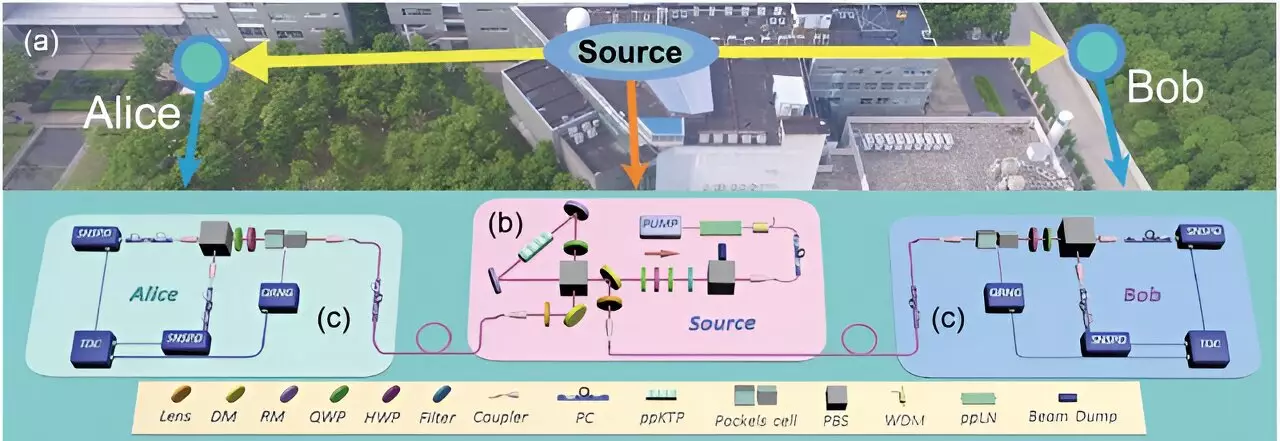The world of quantum mechanics is often home to paradoxes and intriguing phenomena that challenge classical intuitions about reality. Among these is Hardy’s paradox, introduced by physicist Lucien Hardy in the 1990s. This paradox serves as a test of local realism, the classical notion that physical properties exist independently of observation and that no information can travel faster than light. Recent major advancements by a research team from the University of Science and Technology of China (USTC) and Nankai University have shed light on this paradox by closing crucial loopholes, presenting a significant push toward a better understanding of quantum nonlocality.
At its core, Hardy’s paradox illustrates a situation where three events have a zero probability of occurring, yet quantum mechanics predicts a non-zero probability for a fourth event occurring under specific conditions. This contradiction poses serious challenges to local realism, suggesting that reality, or at least our perception of it, might be inherently nonlocal. Such claims can be difficult to verify experimentally, primarily due to the complexity involved in creating ideal conditions. The paradox thus becomes emblematic of the ongoing struggle to reconcile quantum predictions with classical interpretations of reality.
Historically, proving Hardy’s paradox has encountered significant hurdles. Researchers faced two primary issues: the locality loophole and the detection efficiency loophole. The locality loophole arises from a situation where the outcomes of measurements could be influenced by the way measurements are chosen, essentially allowing for predetermined influences inherent to classical physics. Meanwhile, the detection efficiency loophole stems from optical losses that can diminish the effectiveness of entangled photon sources, leading to inaccurate interpretations of data.
Efforts to close these loopholes have historically proven difficult because it requires achieving a delicate balance between the fidelity of entangled sources and accounting for the competing influences in experiments. Consequently, many previous studies have lacked the rigor necessary to definitively challenge local realism.
The recent study executed by the collaborative team tackled these challenges head-on through meticulous experimental design. To address the locality loophole, the researchers structured their experiments to ensure that the measurement choices were space-like separated from both the preparations of the entangled states and detection events. This strategy effectively eliminated any possibility of influencing the measurement settings, thereby reinforcing the validity of their findings.
Equally impressive was the team’s approach to overcoming the detection efficiency loophole. By achieving an impressive 82.2% detection efficiency, they significantly reduced the noise from optical losses, augmenting their data with greater accuracy. Furthermore, the inclusion of high-speed quantum random number generators for selecting measurement settings introduced a level of true randomness to the experiment, mitigating potential biases associated with local hidden variables.
This careful consideration and integration of various elements allow for a comprehensive analysis that tightly constrains the loopholes in Hardy’s paradox. By employing an enhanced version of Hardy’s inequality to examine undetected and double-click events, the researchers fortified the experimental framework, transforming what was once an elusive challenge into a tangible achievement.
The culmination of this rigorous study resulted in the strong violation of Hardy’s paradox. Over the course of approximately six hours and 4.32 billion trials, the research yielded results with a significance level peaking at five standard deviations. Additionally, null hypothesis tests indicated that the findings are incompatible with local realism, showing probabilities lower than 10^-16348. Such extraordinary results reinforce the legitimacy of quantum nonlocality and mark a groundbreaking advancement in the field.
The implications of this research extend far beyond the theoretical realm. With greater understanding of quantum nonlocality, scientists are now primed to explore the development of cutting-edge quantum technologies, such as quantum key distribution and quantum random number generation. These innovations hinge on harnessing the nonlocal features of quantum mechanics, potentially redefining secure communications and computational power.
The successful closing of loopholes in Hardy’s paradox represents a monumental stride in quantum physics. By illuminating the underpinnings of quantum nonlocality, this research not only addresses long-standing theoretical debates but also lays the groundwork for the development of pioneering quantum technologies. As we continue to unpack the mysteries of the quantum realm, one thing remains clear: the journey of exploration and understanding is far from over, and the implications of these findings will resonate in the fields of physics and technology for years to come.

